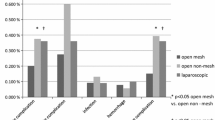Abstract
Introduction
Inguinal hernia repair is one of the most frequently performed procedures. An alternative to mesh repair could be herniotomy, where no mesh is placed and only minimal dissection is done. The European Hernia Society guidelines on the treatment of inguinal hernia in adult patients, which were released in 2009 and expired some time ago, states that all adult (>30 years of age) male patients with a symptomatic inguinal hernia should be operated on using a mesh technique. We hypothesize that the herniotomy is a good alternative to mesh repair in young patients.
Methods
In this retrospective cohort study, the postoperative complications and recurrence rate after a herniotomy procedure were studied. All patients between the ages of 18 and 40 at the time of the surgery were included from January 1st 1997 until December 31st 2010.
Results
In our cohort of 234 patients, the recurrence rate was 4.7 %. When we focus on the patients in the ages ranging from 18 to 25 years old at the time of the surgery, we found a recurrence rate of 0 versus 9.2 % in ages 26–40. These recurrence rates are comparable to those in current literature.
Conclusion
A herniotomy seems to be an efficient procedure with acceptable recurrence rates in patients up to 30 years of age. Postoperative pain seems to be low compared to other techniques. In patients older than 30 years recurrence rates seem to increase which necessitates the use of mesh implants. The main finding is zero recurrences in patients up to 25 years of age. Because there is a limited amount of similar studies that evaluated the complications of a herniotomy, we believe these results warrant the commencement of a randomized controlled trial to add more evidence to this topic. This cohort study is a small, but important contribution to the advice to perform a randomized controlled trial. Based on the limited evidence that is known so far, this procedure might be the treatment of choice in the repair of primary inguinal hernia in young adult patients up to 30 years of age.
Similar content being viewed by others
References
Rutkow IM (2003) Demographic and socioeconomic aspects of hernia repair in the United States in 2003. Surg Clin North Am 83:1045–1051
van Beek E, Boon L, Vlieger EJ (2009) Voorstudie naar Praktijkvariatie in Nederland. Ministerie van Volksgezondheid, Juli
Johnson J, Roth JS, Hazey JW, Pofahl WE (2004) The history of open inguinal hernia repair. Curr Surg 61(1):49–52
Masukawa K, Wilson SE (2010) Is postoperative chronic pain syndrome higher with mesh repair of inguinal hernia? Am Surg 76(10):1115–1118
Amato B, Moja L, Panico S, Persico G, Rispoli C, Rocco N, Moschetti I (2012) Shouldice technique versus other open techniques for inguinal hernia repair. Cochrane Database Syst Rev 4:CD001543
Langeveld HR, van’t Riet M, Weidema WF, Stassen LP, Steyerberg EW, Lange J, Bonjer HJ, Jeekel J (2010) Total extraperitoneal inguinal hernia repair compared with Lichtenstein (the LEVEL-Trial): a randomized controlled trial. Ann Surg 251(5):819–824
Douek M, Smith G, Oshowo A, Stoker DL, Wellwood JM (2003) Prospective randomised controlled trial of laparoscopic versus open inguinal hernia mesh repair: five year follow-up. BMJ 326:1012–1013
Osifo OD, Irowa OO (2008) Indirect inguinal hernia in Nigerian older children and young adults: is herniorrhaphy necessary? Hernia 12(6):635–639
Dutch guideline for inguinal hernias (2003) Richtlijn behandeling van de liesbreuk, Nederlandse Vereniging voor Heelkunde, Van Zuiden Communications B.V. p 35. ISBN 90-8523-001-2
Simons MP, Aufenacker T, Bay-Nielsen M, Bouillot JL, Campanelli G, Conze J, de Lange D, Fortelny R, Heikkinen T, Kingsnorth A, Kukleta J, Morales-Conde S, Nordin P, Schumpelick V, Smedberg S, Smietanski M, Weber G, Miserez M (2009) European Hernia Society guidelines on the treatment of inguinal hernia in adult patients. Hernia 13:343–403
Beets GL, Oosterhuis KJ, Go PMNYH, Baeten CGMI, Kootstra GJ (1997) Longterm follow up (12–15 years) of a randomized controlled trial comparing Bassini-Stetten, Shouldice, and high ligation with narrowing of the internal ring for primary inguinal hernia repair. Am Coll Surg 185:352–357
Langeveld HR, van’t Riet M, Weidema WF, Stassen LP, Steyerberg EW, Lange J, Bonjer HJ, Jeekel J (2010) Total extraperitoneal inguinal hernia repair compared with Lichtenstein (the LEVEL-Trial): a randomized controlled trial. Ann Surg 251(5):819–824
Nienhuijs SW, Rosman C (2015) Long-term outcome after randomizing prolene hernia system, mesh plug repair and Lichtenstein for inguinal hernia repair. Hernia 19(1):77–81
Kucuk HF, Sikar HE, Kurt N, Uzun H, Eser M, Tutal F, Tuncer Y (2010) Lichtenstein or darn procedure in inguinal hernia repair: a prospective randomized comparative study. Hernia 14(4):357–360
Bay-Nielsen M, Perkins FM, Kehlet H, Danish Hernia Database (2001) Pain and functional impairment 1 year after inguinal herniorrhaphy: a nationwide questionnaire study. Ann Surg 233(1):1–7
van den Heuvel B, van Jarwaarde JA, Wichers P, de Lange de Klerk ES, Bonjer HJ, Dwars BJ (2015) Follow-up after laparoscopic inguinal hernia repair, can it be done by phone? A prospective study in 300 patients, the PINQ-PHONE. Surg Endosc 29(11):3292–3297
Nikkolo C, Lepner U (2016) Chronic pain after open inguinal hernia repair. Postgrad Med 128(1):69–75
Author information
Authors and Affiliations
Corresponding author
Ethics declarations
Conflict of interest
GK declares no conflict of interest. LT declares no conflict of interest. WD declares no conflict of interest. LV declares no conflict of interest. PV declares no conflict of interest.
Ethical approval
All procedures in the study were in accordance with the ethical standards of the institutional research committee and with the 1964 Helsinki declaration and its later amendments.
Informed consent
Since our study is a retrospective study no formal consent is required.
Rights and permissions
About this article
Cite this article
van Kerckhoven, G., Toonen, L., Draaisma, W.A. et al. Herniotomy in young adults as an alternative to mesh repair: a retrospective cohort study. Hernia 20, 675–679 (2016). https://doi.org/10.1007/s10029-016-1529-z
Received:
Accepted:
Published:
Issue Date:
DOI: https://doi.org/10.1007/s10029-016-1529-z



